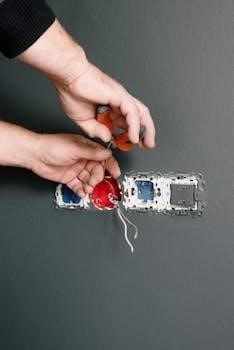The AC compressor clutch facilitates the engagement and disengagement of the compressor pulley from the compressor drive using an electromagnetic switch‚ enabling smooth operation and maintaining the desired temperature;
The AC compressor clutch serves a crucial role in your vehicle’s air conditioning system. Its primary function is to connect and disconnect the AC compressor from the engine’s drive belt. When the air conditioning is turned on‚ the clutch engages‚ linking the spinning pulley to the compressor shaft. This allows the compressor to pressurize the refrigerant‚ initiating the cooling process. Conversely‚ when the AC is off‚ the clutch disengages‚ allowing the pulley to spin freely without driving the compressor. This prevents unnecessary wear and tear on the compressor and reduces engine load. The clutch operates via an electromagnetic coil. When energized‚ it creates a magnetic field that pulls the clutch plate into contact with the pulley‚ engaging the compressor. A properly functioning clutch ensures efficient and reliable air conditioning performance‚ delivering cool air when needed while minimizing strain on the engine when cooling isn’t required.
AC compressors come in two main types⁚ those with a clutch and those without. Traditional systems utilize a clutch‚ an electromagnetic device that engages and disengages the compressor based on cooling demand. When the AC is activated‚ the clutch engages‚ connecting the compressor to the engine’s drive belt. When cooling isn’t needed‚ the clutch disengages‚ stopping the compressor. Clutch-less compressors‚ also known as variable displacement compressors‚ operate continuously. Instead of engaging and disengaging‚ they regulate cooling output by adjusting the internal wobble plate. When cooling is needed‚ the wobble plate increases refrigerant compression; when cooling demand is low‚ the wobble plate reduces compression. Visual cues differentiate the two⁚ clutched compressors have a visible clutch mechanism and coil wire‚ while clutch-less compressors lack these features and often have a control valve. Understanding these differences is crucial for proper diagnosis and maintenance.
Several issues can prevent the AC compressor clutch from engaging‚ including low refrigerant levels‚ a faulty clutch relay‚ a blown fuse‚ a bad AC clutch coil‚ and an excessive air gap.
Low refrigerant levels are a common culprit preventing AC compressor clutch engagement. The low-pressure switch acts as a safety mechanism‚ disabling the compressor when refrigerant pressure drops below a specified threshold. This protects the compressor from damage due to inadequate lubrication‚ as refrigerant carries essential oil.
A significant refrigerant leak can trigger this switch‚ cutting power to the clutch. The minimum low-pressure cut-off varies by vehicle‚ so consult the shop manual.
Bypassing the low-pressure switch to force compressor operation is dangerous and can ruin the compressor if there isn’t enough oil.
Before manually engaging the AC compressor clutch‚ ensure the system has adequate refrigerant pressure to avoid damage.
The clutch relay is an electrical component that controls the engagement of the compressor clutch. A faulty or worn-out relay might fail to send the signal to engage the clutch‚ preventing it from operating.
The contacts within the relay can become pitted or stuck‚ or the relay control coil might not be receiving power or ground. Testing the relay involves checking for battery voltage and ground at the appropriate pins in the socket with the key in the RUN position.
Swapping the AC relay with a similar one can help diagnose a faulty relay. If the replacement relay allows the AC compressor to engage.
A blown fuse in the AC compressor clutch circuit is a common cause of clutch disengagement. The fuse protects the clutch coil from excessive current.
A short in the coil windings or the wiring harness can cause the fuse to blow. Inspect the fuse visually for a broken filament. Replace a blown fuse with one of the same amperage rating.
If the fuse blows repeatedly‚ it indicates an underlying electrical problem that needs further investigation. A short to ground or within the clutch coil itself are possible culprits.
A faulty AC clutch coil is a frequent reason for AC compressor clutch failure. The coil generates a magnetic field attracting the clutch plate‚ engaging the compressor.
If the coil is open‚ shorted‚ or has excessive resistance‚ it won’t create a strong enough magnetic field to pull the clutch plate in. To test‚ disconnect the connector and use a multimeter to measure resistance.
An open coil will show infinite resistance. A shorted coil will show very low resistance‚ possibly near zero. Compare the measured resistance to the manufacturer’s specification. If it deviates significantly‚ the coil is likely defective.
Understanding the AC Compressor Clutch
Function of the AC Compressor Clutch
Types of AC Compressor Clutches⁚ Clutch vs. Clutch-less

Common Causes of AC Compressor Clutch Not Engaging
Low Refrigerant Levels and the Low-Pressure Switch
Faulty Clutch Relay
Blown Fuse
Bad AC Clutch Coil
Excessive AC Clutch Air Gap
The air gap is the distance between the clutch disc and the compressor pulley. This gap must be within the manufacturer’s specified range for proper engagement. If the gap is too large‚ the magnetic field generated by the clutch coil may not be strong enough to pull the clutch disc against the pulley.
This results in the clutch not engaging‚ or intermittent engagement. Over time‚ the clutch faces wear down‚ increasing the air gap. You can measure the air gap using a feeler gauge.
Consult your vehicle’s service manual for the correct specification. If the air gap is too large‚ you may be able to shim the clutch to reduce the gap‚ or the clutch assembly may need replacement.

Troubleshooting Steps Before Manual Engagement
Before manually engaging‚ perform visual checks for obstructions or damage. Check power at the connector and test the AC clutch relay to pinpoint the issue’s source.
Visual Inspection of the Clutch
Begin by carefully examining the AC compressor clutch for any obvious signs of damage or wear. Look for cracks‚ broken wires‚ or loose connections. Ensure that there are no obstructions preventing the clutch from engaging properly. Check the clutch plate for excessive rust or corrosion‚ which could hinder its ability to make a solid connection with the pulley.
Inspect the wiring harness connected to the clutch coil for any frayed or damaged wires. Use a flashlight to get a better view of the components. Pay close attention to the air gap between the clutch plate and the pulley; an excessively large gap can prevent engagement. Also‚ verify that the pulley spins freely without any unusual noises or wobbling. If any of these issues are present‚ they need to be addressed before attempting manual engagement. A thorough visual inspection can often reveal the underlying cause of the problem‚ saving time and effort in the troubleshooting process.
Checking for Power at the Clutch Connector
Before attempting to manually engage the AC compressor clutch‚ verify that power is reaching the clutch connector. Disconnect the connector from the compressor and use a multimeter set to DC volts to check for voltage at the connector terminals. Some AC compressor connectors have a single terminal that provides power‚ with the compressor case serving as the ground. Others have two wires‚ one for power and one for ground.
With the engine running and the AC turned on‚ you should see approximately 12 volts at the connector. If there is no voltage‚ check the AC clutch fuse and relay. If power is present but the clutch is not engaging‚ the issue may be a bad AC clutch coil or an excessive air gap. This step helps isolate whether the problem lies within the electrical circuit or the clutch mechanism itself.
Testing the AC Clutch Relay
The AC clutch relay is crucial for engaging the compressor clutch. To test it‚ first‚ locate the relay in the fuse box‚ consulting your vehicle’s manual for its precise location. Remove the relay and examine its condition‚ looking for any signs of damage or corrosion. Refer to a relay diagram to identify the pins that should have battery voltage when the key is in the RUN position and those that should have ground when the high and low pressures are within limits.
If the power and ground checks out in the relay socket‚ test the relay by swapping in a similar relay. If you hear the relay click when activating the AC‚ move on to the next step to check the integrity of the wiring harness and ground. If swapping the relay resolves the issue‚ the original relay is faulty and needs replacement.

Step-by-Step Guide to Manually Engaging the AC Compressor Clutch
Manually engaging the AC compressor clutch can help diagnose whether the clutch itself or other components are at fault. Before starting‚ ensure the engine is off and the vehicle is safely parked. Locate the AC compressor clutch‚ typically found at the front of the compressor. Visually inspect the clutch for any obstructions or damage.
Next‚ use a jumper wire to bypass the electrical circuit that normally engages the clutch. Connect one end of the jumper wire to the positive terminal of the battery and the other end to the positive terminal of the AC compressor clutch connector. Be cautious to avoid shorting any wires. If the clutch engages‚ the issue likely lies within the electrical circuit‚ such as a faulty relay or low refrigerant level. If it doesn’t engage‚ the clutch itself may be defective.

Safety Precautions
Before manually engaging the AC compressor clutch‚ prioritize safety. Disconnect the negative battery terminal to prevent electrical shocks or short circuits during the process. Ensure the vehicle is parked on a level surface and the parking brake is engaged to prevent any unexpected movement.
Wear safety glasses to protect your eyes from debris or sparks. Avoid wearing loose clothing or jewelry that could get caught in moving parts. Never bypass any safety switches or sensors‚ as they are designed to protect the AC system and prevent damage. If you are unsure about any step‚ consult a qualified mechanic.
Be extremely careful when working with electrical connections and avoid touching any exposed wires. Use insulated tools to prevent accidental shorts. If you smell burning or see smoke‚ immediately disconnect the battery and stop the procedure. Remember‚ safety is paramount when working on any automotive system.




